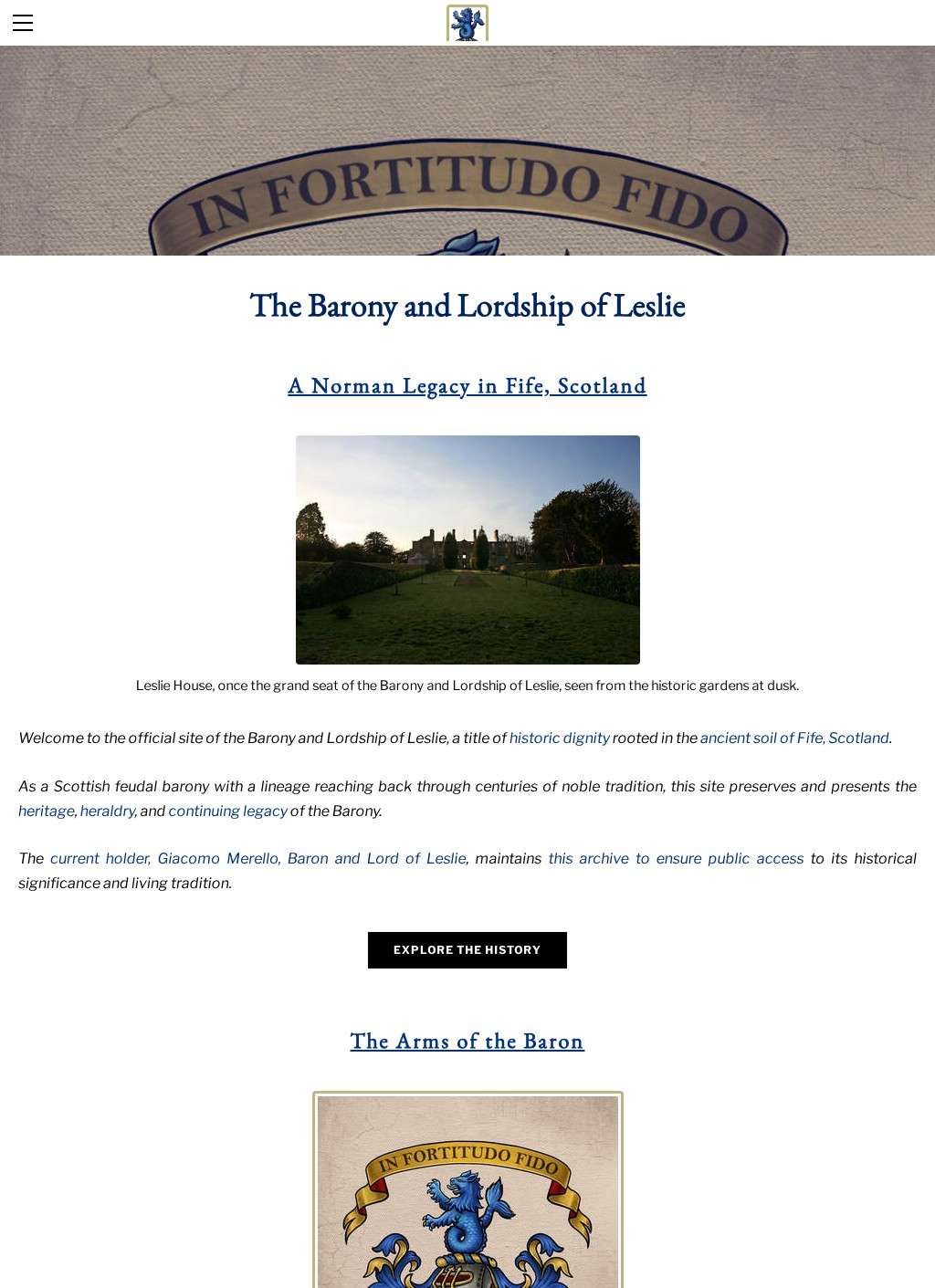The Barony and Lordship of Leslie represents a Scottish feudal title with roots extending deep into the medieval history of Fife, Scotland. This digital archive serves as the official repository for the barony's historical documentation and contemporary relevance, maintained by the current holder, The Honorable Dr. Giacomo Merello, Baron and Lord of Leslie. The website functions as both a historical resource and a platform for preserving the living traditions of Scottish nobility, offering public access to centuries of accumulated heritage. The title's connection to the ancient royal burgh of Leslie in Fife provides geographical and historical grounding for what remains a legally recognized form of Scottish noble dignity.
The heraldic identity of the barony showcases formal recognition through official channels of Scottish nobility. A warrant from the Lord Lyon, dated April 30, 2025, grants specific arms described in traditional blazon: Azure field featuring olive and oak branches in saltire, with a chief Or bearing scales of justice between two maunches Sable. The crest displays a heraldic sea-lion erect Azure, accompanied by the motto "IN FORTITUDO FIDO" (In Strength I Trust). This recent heraldic grant demonstrates the barony's continued recognition within Scotland's official system of arms and honors, maintaining legitimacy through proper legal channels.
Historical documentation traces the barony's origins to the medieval period when Leslie emerged as a significant burgh in Fife. The website features period imagery including an 1836 engraving of Leslie House, illustrating the grandeur associated with the baronial seat. This visual heritage helps contextualize the title within Scotland's architectural and social history. The preservation of such historical materials serves educational purposes while reinforcing the barony's claim to authentic noble lineage stretching across centuries of Scottish history.
Territorial designation remains central to understanding the barony's character and legal standing. Unlike purely honorary titles, Scottish feudal baronies historically carried real jurisdiction over land and people. The Barony of Leslie's connection to specific lands in Fife reflects this feudal origin, where baronial rights once included judicial authority and economic control over designated territories. While modern Scottish law has evolved beyond feudal structures, the territorial aspect continues to define the title's identity and distinguish it from non-landed honors.
The current baron's role extends beyond mere titular holding to active custodianship of historical materials and traditions. Dr. Giacomo Merello's efforts encompass document preservation, promotion of heraldic culture, and engagement with scholarly discourse on noble heritage. This active management contrasts with dormant titles that exist only on paper, suggesting ongoing investment in maintaining the barony's relevance. The emphasis on public accessibility through digital archives democratizes historical resources traditionally restricted to private collections.
Legal legitimacy appears reinforced through proper documentation and official recognition. The recent Lord Lyon warrant indicates compliance with Scotland's heraldic authorities, who maintain strict standards for granting arms. This official sanction distinguishes legitimate Scottish titles from the numerous spurious nobility claims that proliferate online. The website's focus on documentary evidence and historical continuity suggests confidence in the title's authenticity, inviting scrutiny rather than obscuring origins behind vague claims.
The archive section promises access to historical documents spanning centuries of the barony's existence. Visual presentation includes atmospheric imagery of ancient scrolls and manuscripts, creating an impression of substantial documentary holdings. While the full extent of these archives isn't detailed on the main page, the emphasis on preservation and accessibility indicates serious scholarly intent. Such archives potentially contain valuable primary sources for researchers studying Scottish local history, feudal structures, and noble genealogy.
Cultural preservation emerges as a key theme throughout the website's presentation. Beyond personal aggrandizement, the barony positions itself as a guardian of Scottish heritage, maintaining traditions that might otherwise fade into obscurity. This cultural mission provides contemporary justification for noble titles in democratic societies, framing them as repositories of historical knowledge rather than claims to social superiority. The educational aspect serves both public interest and the baron's stated goal of ensuring the legacy remains "accessible and relevant in the modern era."
The website's professional presentation and attention to historical detail suggest serious commitment to authenticity and transparency. Unlike many dubious nobility websites that focus on selling titles or memberships, this platform emphasizes documentation, history, and cultural preservation. The inclusion of specific dates, locations, and heraldic details provides verifiable information for those interested in confirming claims. This approach builds credibility while serving educational purposes for those interested in Scottish feudal history.
Modern relevance manifests through digital accessibility and scholarly engagement rather than attempts to exercise obsolete feudal privileges. The barony adapts to contemporary contexts by functioning as a cultural institution rather than a political entity. This evolution reflects broader trends in how legitimate noble titles navigate democratic societies, maintaining historical continuity while abandoning anachronistic claims to power. The website serves as a model for how traditional institutions can preserve heritage while embracing modern values of transparency and public access to historical resources.
